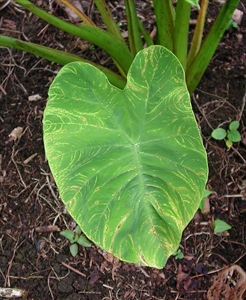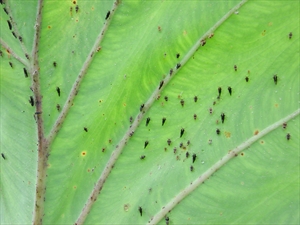- Narrow distribution. Philippines (taro vein chlorosis), Oceania (taro vein chlorosis and Colocasia bobone disease). The viruses causing these diseases are:
- CBDV - infects all taro. Virus causes: i) dark green distorted patches in leaves that then recover, ii) alomae with other (unknown) viruses - plants (called ‘male’ taro in Solomon Islands) die. In a few alomae resistant varieties (called ‘female’ taro in Solomon Islands) CBDV causes bobone - stunted, thickened, green twisted leaves that eventually recover and appear healthy.
- TaVCV - infects all taro. Virus causes bright yellow, feather-like patterns, often above the veins at margins of leaves. The veins turn brown with age.
- Spread of CBDV by planthoppers; spread of TaVCV presumed to be planthoppers. TaVCV exists as at least two strains, Fiji and Vanuatu.
- Natural enemies: egg-sucking bug, Cyrtorhinus.
- Cultural control: remove plants with alomae as soon as seen (cover plant with e.g., rice bag, pull out capturing planthoppers) and burn; avoid growing varieties susceptible to alomae; grow ‘female’ taro if varieties available; avoid planting near plots with alomae.
- Chemical control: use synthetic pyrethroids against planthoppers, but they will likely kill natural enemies. Test Derris (fish poison).











